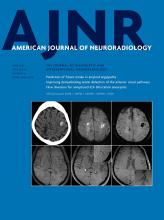Research ArticlePediatrics
Susceptibility-Weighted Imaging of the Pediatric Brain after Repeat Doses of Gadolinium-Based Contrast Agent
K. Ozturk and D. Nascene
American Journal of Neuroradiology June 2021, 42 (6) 1136-1143; DOI: https://doi.org/10.3174/ajnr.A7143
K. Ozturk
aFrom the Department of Radiology, University of Minnesota, Minneapolis, Minnesota
D. Nascene
aFrom the Department of Radiology, University of Minnesota, Minneapolis, Minnesota

References
- 1.↵
- 2.↵
- 3.↵
- 4.↵
- Rossi Espagnet MC,
- Bernardi B,
- Pasquini L, et al
- 5.↵
- 6.↵
- 7.↵
- Tamrazi B,
- Nguyen B,
- Liu CJ, et al
- 8.↵
- 9.↵
- Ginat DT,
- Meyers SP
- 10.↵
- 11.↵
- Haacke EM,
- Mittal S,
- Wu Z, et al
- 12.↵
- Nandigam RN,
- Viswanathan A,
- Delgado P, et al
- 13.↵
- 14.↵
- Kanda T,
- Ishii K,
- Kawaguchi H, et al
- 15.↵
- 16.↵
- Moser FG,
- Watterson CT,
- Weiss S, et al
- 17.↵
- 18.↵
- Ozturk K,
- Nas OF,
- Soylu E, et al
- 19.↵
- 20.↵
- 21.↵
- Runge VM
- 22.↵
- 23.↵
- 24.↵
- Radbruch A,
- Haase R,
- Kickingereder P, et al
- 25.↵
- 26.↵
- 27.↵
- Radbruch A,
- Weberling LD,
- Kieslich PJ, et al
- 28.↵
- 29.↵
- 30.↵
- 31.↵
- Bilgic B,
- Pfefferbaum A,
- Rohlfing T, et al
- 32.↵
- 33.↵
- Kanda T,
- Fukusato T,
- Matsuda M, et al
In this issue
American Journal of Neuroradiology
Vol. 42, Issue 6
1 Jun 2021
Advertisement
K. Ozturk, D. Nascene
Susceptibility-Weighted Imaging of the Pediatric Brain after Repeat Doses of Gadolinium-Based Contrast Agent
American Journal of Neuroradiology Jun 2021, 42 (6) 1136-1143; DOI: 10.3174/ajnr.A7143
0 Responses
Jump to section
Related Articles
- No related articles found.
Cited By...
- No citing articles found.
This article has been cited by the following articles in journals that are participating in Crossref Cited-by Linking.
- Minglei Ouyang, Li BaoJournal of Magnetic Resonance Imaging 2025 61 1
More in this TOC Section
Similar Articles
Advertisement











